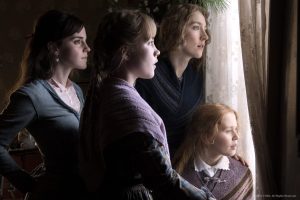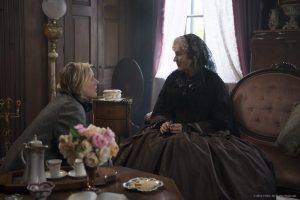What “Little Women” Teaches Us About Rebranding

Published on March 9, 2020, at 8:53 p.m.
by Olivia Carroll.
Greta Gerwig’s adaptation of “Little Women” took the world by storm. The film reshapes the classic story of the March sisters — Meg, Jo, Amy and Beth — from a book that walks the line between tradition and independence to a new version that showcases the struggle between desires, duties and fears that women face.
With this version, Gerwig made a choice to rebrand from a story that refrains from taking a stance on feminism to one that fully embraces women who “have minds and … have souls, as well as just hearts.” As we watch “Little Women” and see all of the adjustments made, public relations practitioners should take note of how Gerwig rebranded a classic story into a new favorite.
Know your audience.
When rebranding, it is important to remember what the audience has already accepted about your brand and what the audience wants to see. Previous adaptations of “Little Women” framed the March sisters as women whose lives and struggles became nonessential to the story once they were married or dead. The men were constantly portrayed as the saviors, the determined little sister was remembered as the villain, and Jo March was a woman in need of saving by a man — a man who delivered Jo’s book to the publishing house in the 1994 movie adaptation.
In a modern world where women are more than simply mothers, Gerwig shows the struggles of women who aim to surpass the requirement of marriage. Amy is full of aspirations and crushed with the knowledge that her job is to marry rich and that she must ignore love for the purpose of economic gain. Jo is propelled by the loss of her sister Beth to write a novel on the story of her and her sisters. In Gerwig’s version, it is Jo who delivers her own book to the publisher. Gerwig alters the portrayal of the women in order to better reach a modern audience who fully supports the idea of women who want “to be great or nothing.”
Just as Gerwig is conscious of the opinions of her audience, PR practitioners must be aware of what our audience is thinking, which audience we are reaching and which new audience we need to reach for. Knowing who our audience is, whether they are long-term customers or newcomers, allows us to target our rebranding to give them what they want.
Find a new angle.
Forbes writer Serenity Gibbons wrote, “Every industry has its rules. Many of them can and should be broken.” When Gerwig began writing her adaptation to the literary classic, she broke outside the pages of “Little Women” to take a look at the story behind it all. Gerwig began researching the author, Louisa May Alcott, to get a better understanding of what this story was trying to convey to the audience. This new look at a classic story allowed Gerwig to reimagine Jo with the personality, tendencies and even quotes of Alcott mixed within this fictional story.
By breaking outside the boundaries set before her, Gerwig combined elements of Jo and Alcott to present an entirely new angle in which the audience can see the fictional Jo handle the realistic struggles Alcott faced during this time. At a point of intense emotional heartbreak, Jo says, “I’m sick of people saying that love is all a woman is fit for. I’m so sick of it! But — I’m so lonely.”

With her research, Gerwig was able to combine lines written in the book with qualities of Alcott’s life, such as the addition of “I’m so lonely” that alludes to Alcott’s loneliness throughout her life, to find a new angle that created an emotional appeal to reach the heart of each audience member. When rebranding, it is necessary to look outside the box and break boundaries to see what innovative strategies and tactics can be used to elevate our brand.
Evaluate the structure.
Sometimes restructuring the material reshapes the message entirely. Gerwig took this challenge quite literally. She presents a story that uses flashbacks to parallel the timelines of Volume 1 and Volume 2 of “Little Women,” as the novel was originally published in two volumes. This restructuring creates a new flow of the story that connects the defining occurrences of the characters’ youth with the events of their adult lives.
Gerwig used a variety of elements, including costuming, scriptwriting and coloration to lead the audience down a new path while keeping the integrity of the original piece in place. This restructuring allowed Gerwig to convey her message that no matter what, you cannot go back to the way things were. Gerwig told Huffpost, “If I told it linear, I would lose the ability to do what I’m interested in.” When reevaluating our brands, we should keep in mind that sometimes we have to move the strategy, tactics or target audience around in order to present a story that flows better with our brand.
Don’t get rid of everything.
Gerwig did not reinvent the wheel; she just found a new way to make it spin. Gerwig told Deadline that she originally read the book when she was around 14 or 15 years old and decided to reread it when she was 30. Though she expected to love it the same way again, she found a completely new experience. Gerwig said, “This book is about women, ambition, money, and art. And it was about the intersection of those things.”
For Gerwig, this new point of view meant keeping the classic story but changing the way audiences interacted with the characters. For us, this means taking the foundation our brand has built and changing the way the public interacts with it.

In this new adaptation, Amy March, a character often regarded as the villain of the March sisters, is given a chance to be redeemed. Gerwig took a character who was hated for the way she expressed her desires and seized the things she wanted by instead showcasing how “she can’t necessarily change the world, but she’s going to figure out how to win.” Instead of dismissing Amy, Gerwig figured out a way to take the least liked aspect of a story and turn her into a representation of a young, spunky girl fighting for her place in the world. Sometimes, rebranding is not about ditching the things that were received badly, but taking foundational elements and repositioning them to be seen in a new light.
Give it credibility.
As if it wasn’t enough to adapt a classic written by one of the most well-known authors to ever exist, Gerwig went a step further and cast some of the most well-known actors and actresses across modern generations. The cast list for “Little Women” includes Meryl Streep, Emma Watson, Laura Dern, Florence Pugh, Saoirse Ronan and Timothée Chalamet, just to name a few.
This movie is filled to the brim with acclaimed professionals both on and off the screen. When we want people to see the changes in our brand we use credible personnel to catch the eye of the public and make them see what we are offering. Gerwig shows that for the audience to give us the recognition we need, we have to give them a recognizable, credible spokesperson.
Since its release in 1868, “Little Women” has been adapted into radio shows, plays, an opera, several films, TV specials and has inspired plenty of other creations. This new adaptation teaches us a thing or two about public relations rebranding — Greta Gerwig refocused a classic story to give her audience a modern identity that continues to evolve with them in mind.




